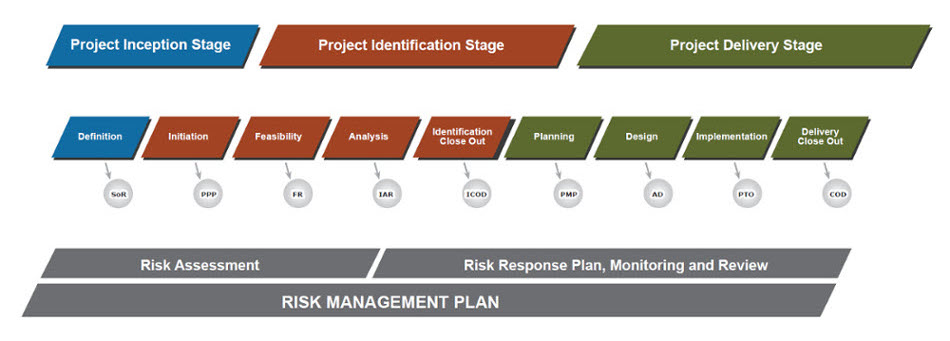Risk Management
Description
Risk in real property projects is “an uncertain event or condition that if it occurs will have either a positive or negative effect on one or more of project’s objectives, which are usually cost, time, scope and quality” (Project Management Institute).
Since most decisions for the undertaking of projects are usually made prior to the compilation of all information, there is a tendency for some degree of uncertainty or risk to the realisation of the project objective(s). In order to support and improve the ability and certainty for the decision making, or approval processes, all potential risks to the outcome of the project should be taken into consideration. This requires a process that not only identifies the potential risks but also provides plans and strategies for managing the risks effectively throughout the project life.
The Public Services and Procurement Canada (PSPC) Policy on Integrated Risk Management (082) (available on Government of Canada network only) states that the department must employ integrated risk management to address uncertainty and maximize opportunity in decision making, priority setting and the achievement of organizational objectives.
The requirements for the consideration of risks in projects is described in the Policy on the National Project Management System (106) (available on Government of Canada network only), which state that risk identification is one of the National Project Management System (NPMS) principles applicable to all PSPC projects, as an assessment of the solution undertaken in order to ensure best value and to meet business objectives. The policy also states that the Branch/Agency Heads and Regional Director Generals (RDGs) are responsible to report on project performance and risks.
In order to support the above requirements, the National Project Management System Directive on Risk Management for Real Property Projects has been prepared to provide the principles and guidelines for risk management in the delivery of real property projects. Contained with this directive are:
- the deliverable requirements—refer to the directive’s Annex B: National Project Management System deliverables for risk management for the table of deliverables and the process map
- definitions
Objective
To ensure that risks to the solutions of real property projects are identified, assessed and managed in a systematic manner throughout the phases of the project as defined in NPMS, as well as meet the requirements from Treasury Board Framework for the Management of Risk and PSPC Policy on Integrated Risk Management.
Real Property context
Risk management is an essential component in the delivery of real property projects. It supports decision making in project approvals and it forms part of the activities in project planning whereby adequate and effective strategies, budgets and schedules are established to respond to the potential risk events. It is a proactive and continuous process that consists of 5 steps, which are defined in the PSPC Risk Management Guide (please contact sngp.npms@tpsgc-pwgsc.gc.ca to obtain this guide) as follows:
- establishing the context
- assessing the risks
- responding to the risks
- monitoring the risks
- communication and consultation with stakeholders regarding the risks
The key deliverable in risk management process is a risk management plan (RMP), which contains various documents that detail the resultant information from completing the five steps listed above. Below is the diagram of the NPMS Model that describe the key RMP activities and deliverables for projects where all 3 NPMS stages are applicable. Refer to Annex B: National Project Management System deliverables for risk management of the National Project Management System Directive on Risk Management for Real Property Projects for more details.
Risk Management Diagram

Image description
Risk assessment
- Project Inception Stage
- Definition Phase
- Statement of Requirements
- Preliminary risk assessment
- Definition Phase
- Project Identification Stage
- Initiation Phase
- Preliminary Project Plan
- Review and update risk assessment
- Feasibility
- Feasibility Report
- Risk assessment for each option and develop risk profile
- Analysis
- Investment Analysis Report
- Review and update risk assessment, complete risk response plan, establish risk allowance for selected option
- Initiation Phase
Risk response plan, monitoring and review
- Project Identification Stage
- Identification Close Out
- Identification Close Out Document
- Ensure latest and up-to-date risk assessment and risk response plan are identified in the Identification Close Out Document (ICOD)
- Identification Close Out
- Project Delivery Stage
- Planning
- Project Management Plan
- Review and update risk assessment, risk response plan and risk allowance
- Design
- Approval Document
- Review and update risk assessment, risk response plan and risk allowance
- Update monitoring record
- Implementation
- Product Turn-over
- Review and update risk assessment, risk response plan and risk allowance
- Update monitoring record
- Delivery Close Out
- Close Out Document
- Update risk assessment, risk response plan and monitoring record to reflect the risks that occurred
- Planning
The NPMS Directive on Risk Management for Real Property Projects is also accompanied by the Risk Management Plan Guide (document available on the Real Property National Project Management System related documents page, available on Government of Canada network only), which provides further guidance in the development of the RMP. It contains a link to the new RMP template.
Risk management toolkit
- Refer to the NPMS Forms and Related Links, for the tools, templates and other related references
Related documents
- National Project Management System Directive on Risk Management for Real Property Projects
- Public Services and Procurement Canada Policy on Integrated Risk Management (082) (available on Government of Canada network only)
- Risk Management Guide (2014) (please contact sngp.npms@tpsgc-pwgsc.gc.ca to obtain this guide)
- Risk Management Plan Guide (document available on the Real Property National Project Management System related documents page, available on Government of Canada network only)
- Policy on National Project Management System Policy (106) (available on Government of Canada network only)
- Treasury Board Framework for the Management of Risk
- Treasury Board Guide to Integrated Risk Management
- Date modified: